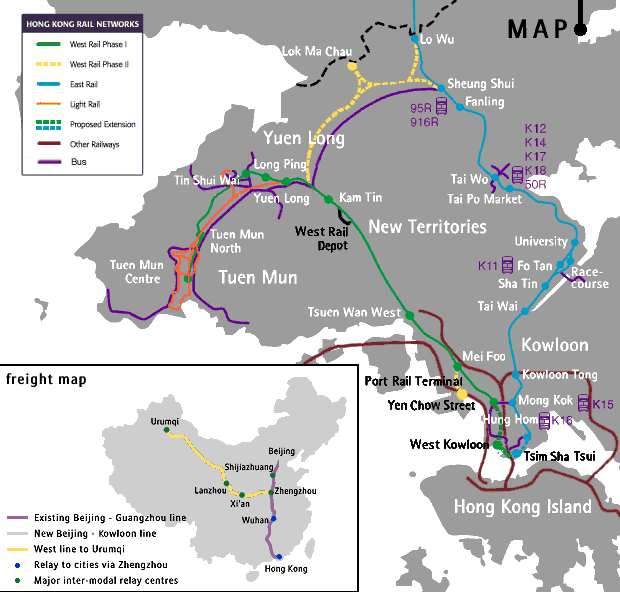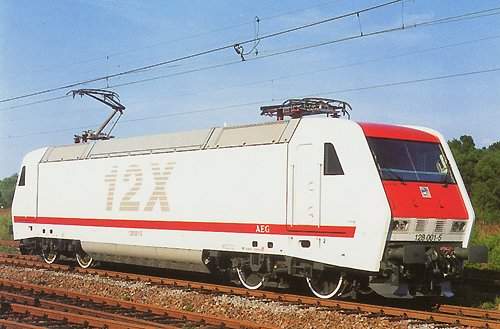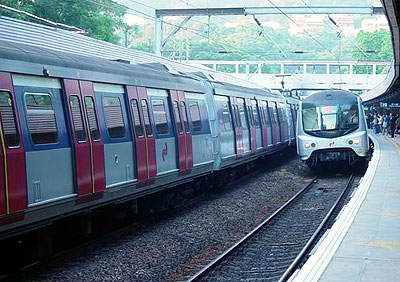The Hong Kong Special Administrative Region and the neighbouring Shenzhen Special Economic Zone in southern China represent one of the world’s largest and fastest growing business areas.
A single track railway opened in 1910 from the Lo Wu border crossing to Kowloon, the link with Canton (since re-designated Guangzhou) creating a title that was adopted by the public body constituted in 1982, the Kowloon-Canton Railway Corporation (KCRC).
Development in Hong Kong’s New Territories, and immediately across the border from the former British colony, was well underway at the time of the sovereignty transfer in 1997.
Patronage of the East Rail route since it was electrified has soared almost six-fold. This demand is met by a fleet of 451 GEC-Alsthom-built EMU vehicles, now formed into 12-car units. They share the same tracks as trains continuing to Shanghai and Beijing, as well as commercially vital freight trains, mainly container traffic, serving a wide variety of destinations.
Rail operators have been pioneers in the use of contactless smart card technology for ticket payment. With a 95% take-up by the Hong Kong population, and usable for buying other goods and the services, the Octopus card, is validated by a contactless system, greatly reducing machinery and maintenance costs.
The project
Until 25kV AC electrification to the new town of Sha Tin in 1982, the original KCR route (later termed East Rail) hosted mainly slow cross-border freights and stopping trains to Lo Wu, with infrequent Canton services. Track doubling and the introduction of fast and frequent high-density EMU services over this and later lines was to become the main means of spreading Hong Kong’s population and production beyond the original urban centres on the Kowloon peninsular and north shore of Hong Kong island. The maintenance centre is at Ho Tung Lau, where updating of the earlier EMU units has been carried out.
The KCRC system is intensively used. A Ma on Shan line was opened to facilitate more development north-east from East Rail at Tai Wai. Also opening in 2004, a short tunnel extension goes beyond the main Hung Hom terminal to East Tsim Sha Tsui in the heart of Kowloon’s retail and hotel area.
KCR West Rail is a 30.5km-long heavy rail mass transit system between urban Kowloon and the New North West Territories. By Hong Kong standards, ridership on the 30.5km line has not been high, although this may change with an opening scheduled for 2009 of the 3.8km Kowloon Southern Link. With one intermediate station, it will connect the present terminus at Nam Cheong with East Rail at East Tsim Sha Tsui.
Scheduled for completion in 2007, the 7.4km (4.6 mile) Lok Ma Chau Spur is being built to provide a second line between Hong Kong and mainland China, the primary purpose being to reduce congestion at Lo Wu station. It will run from East Rail’s Sheung Shui station to Lok Ma Chau where new customs and immigration facilities will be built, with foot access to the Shenzen metro.
KCRC also operates a 36.2km (22.5-mile) light rail system serving intensively developed residential areas in the North West New Territories. Operated by 119 Australian Comeng trams, the standard gauge system provides interchanges with KCR West Rail. Except for Light Rail at 750V DC, KCR routes feature a 25kV AC overhead power supply.
Infrastructure
With extremely high land values, commercial development of properties forms a significant aspect of the corporation’s operation. Major improvements started with the Hung Hom terminus in 1995. The HK$1.3bn project included a new departure hall capable of accommodating 1,600 passengers, enlarged customs and immigration areas, and a wide range of shops and catering outlets.
It increased the handling capability from 180,000 to 250,000 passengers per day. Mongkok Freight Terminal has been extended with the addition of a new freight handling facility, built on reclaimed land in Hung Hom Bay.
Rolling stock
A major refurbishment of GEC Alsthom stock was undertaken from 1996 at a cost of HK$1.25bn spread over three years. The primary aim was to increase the trains’ capacity by 15%, but at the same time, extra additions were made for passenger comfort in the shape of brightly coloured handrails, and hopper ventilation windows. New passenger information displays were also provided.
The trains have been given an improved traction package, incorporating up-to-date electronic control systems. More recent deliveries from 2001 have been high-density EMU SP1900/1950 vehicles in various configurations from Kinki Sharyo of Japan: 95 cars for East Rail, 154 for West Rail and 72 for Ma On Shan.
Longer journeys are serviced by double-deck rakes of rolling stock, designated KTT, which are capable of push-pull operation. Each rake comprises five standard class coaches and one first class vehicle, and is powered by a locomotive type derived from the Swiss Lok 2000 design (SBB Class 460), and built by Adtranz and SLM of Switzerland. Coaches are supplied by Kinki Sharyo.
Five Siemens Series 8000 Eurorunner (similar to Austrian Railways Class 2016) diesels provide freight haulage. Chinese locomotives work through passenger services to Hong Kong.
Signalling
A signalling upgrade is an integral part of the drive to increase capacity and improve reliability on a system that has become prone to failures and a cause of delays to the KCRC. The railway corporation is working on ways to improve the technology, and has already installed Automatic Train Protection (ATP) in place of the earlier Automatic Train Control.
ATP initially saw certain services operate at a reduced frequency, but it has not affected through express and freight trains that pass along the KCRC lines.
The future
The population and economy continue to grow, indicating a future need for more rail investment to serve this market. That investment is now being channelled into completing links between West Rail and other heavy rail lines to provide a flexible transport system, which includes KCRC buses and light rail.
More new lines are also at the planning stage. The KCRC completed the design work on the Sha Tin Central Link in 2004 and submitted to the Government for approval. Another proposal is the 11km (6.8 mile) Northern Link between Kam Sheung Road and Lok Ma Chau, with an interchange for the Lok Ma Chau Spur Line for East Rail passengers.
The KCR as an organisational entity is likely to be lost under a merger favoured by the Hong Kong government, whereby the Mass Transit Railway (MTR), would become the operator of KCR assets.











